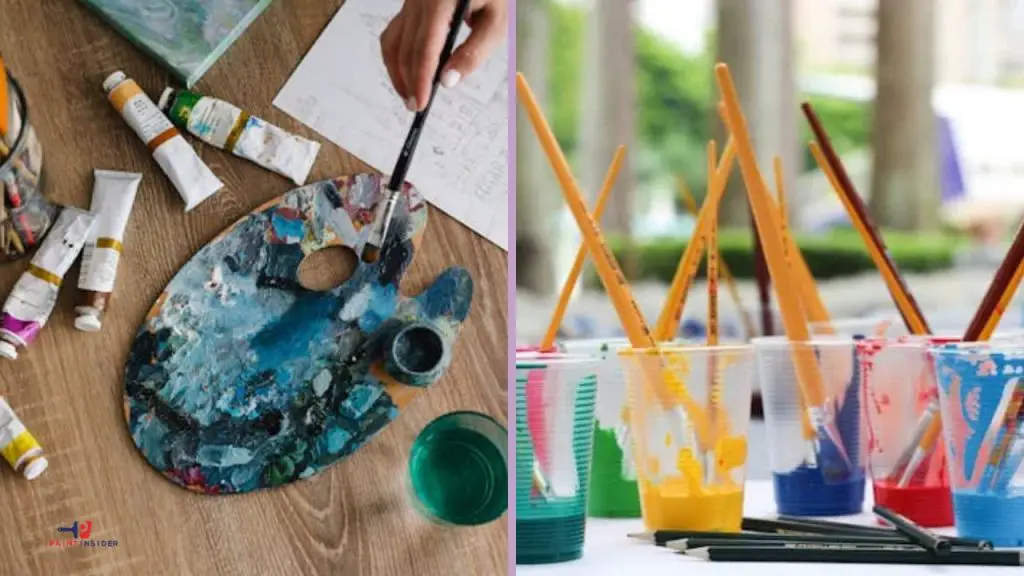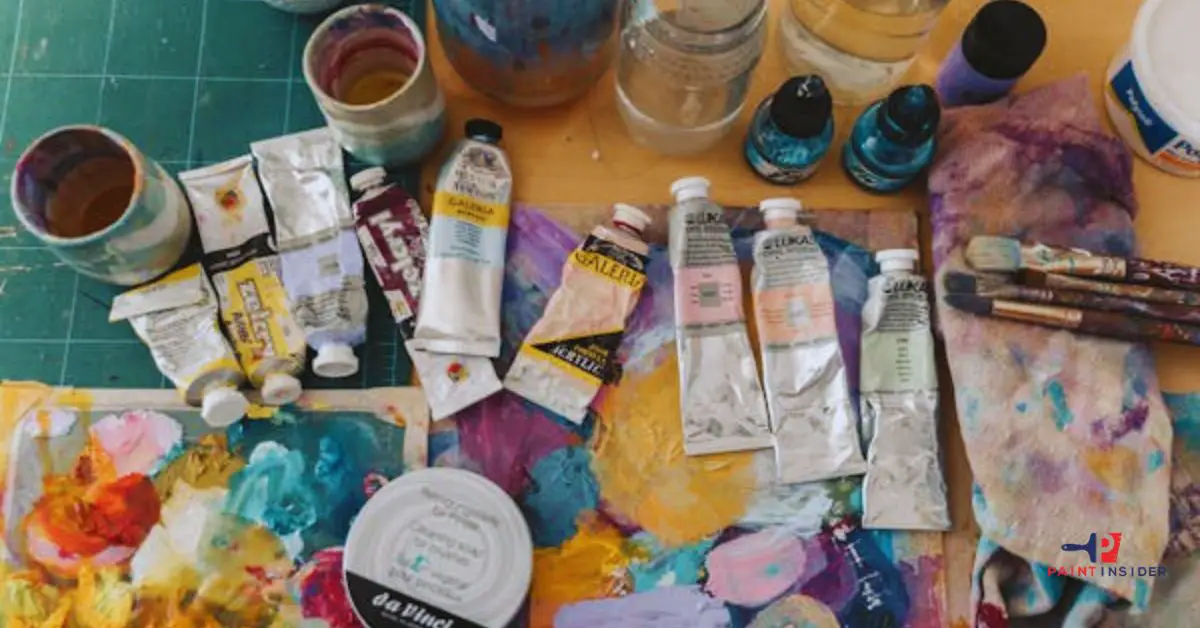Yes, acrylic paint is water-based. It’s made of pigment suspended in an acrylic polymer emulsion, which is water-soluble when wet. This water-based formulation makes it easy to dilute, apply, and clean up with just water. Once it dries, however, acrylic paint becomes water-resistant and forms a durable, flexible surface that adheres well to a variety of materials. This combination of ease of use and durability is why acrylic paint is popular with both beginners and professional artists.
Understanding Acrylic Paint Basics
Acrylic paint is popular for artists because of its bright colors and flexibility. It’s water-based, so it can be easily thinned with water or mixed with different mediums to create various textures and effects. This makes it great for both beginners and pros, without needing strong solvents like oil paints do.
- Composition and Properties: Acrylic paint is a water-based medium, meaning it uses water as its primary solvent. This makes it versatile and easy to clean up, unlike oil paints which require solvents. The quick-drying nature of acrylics allows artists to layer their work efficiently, enabling them to create textures and effects without lengthy waiting periods.
- Types of Acrylic Paint: There are various types of acrylic paints, ranging from heavy body for thick applications to fluid acrylics for finer details. Each type offers unique features heavy body paints maintain brush strokes well, while fluid paints flow smoothly when applied. This diversity provides endless possibilities for creativity.
- Mixing and Color Properties: Experimenting with mixable mediums is part of the fun! You can combine pigments with gels or pastes to change texture or achieve different finishes such as matte or glossy. Additionally, remember that colors often dry darker than they appear when wet; this can be both a challenge and an exciting opportunity for discovery in color mixing.
Unlock the potential that comes with understanding acrylic paint basics. Whether you’re painting on canvas or trying crafts at home, knowing how these pigments behave will take your artistry to new heights!
Water Solubility Explained
Water solubility is the ability of a substance to dissolve in water, and it’s a fascinating interplay of chemistry and nature that impacts everything from environmental processes to everyday products. When we think about acrylic paint, many wonder: is acrylic paint water-based? The answer lies in its composition. Acrylics consist of pigment suspended in a polymer emulsion that primarily uses water as its solvent. This characteristic not only allows for easy cleanup with soap and water but also means that the paint retains flexibility once dry, creating vibrant artwork with enduring appeal.
Acrylic paint is water-based, which makes it better for the environment than oil paints. Oil paints need strong chemicals like turpentine to clean up, which can be harmful, but acrylics don’t. They also dry quickly, so artists can add layers faster without losing color quality. For artists who care about the planet, acrylic paint is a great choice, it’s safe, easy to use, and still allows lots of creative possibilities. So next time you use acrylics, remember that they’re not only great for your art but also kinder to the environment!
Common Uses of Acrylic Paint
- Canvas Art: One of the most popular uses of acrylic paint is creating stunning canvas artworks. Its vibrant colors and quick-drying properties make it a favorite among artists, allowing for layering and texture without lengthy wait times. The versatility means that both fine details and bold strokes can coexist beautifully on a single canvas.
- DIY Home Decor Projects: Acrylic paint is not just for professional artists; it’s also a fantastic medium for DIY enthusiasts looking to breathe new life into their home decor. Think about personalizing furniture, like upcycling an old chair with bright hues or painting intricate designs on wooden frames. Its water-based nature makes cleanup easy, encouraging creative experimentation without the mess.
- Mixed Media Creations: For those who love to combine different artistic styles, acrylic paint shines in mixed media projects. It adheres well to various surfaces from paper to fabric, making it perfect for collages or textile art pieces. This flexibility opens up endless possibilities for creativity, allowing artists to add depth and dimension by incorporating other materials alongside their painted components.
- For Beginners: Acrylics are often recommended for beginners due to their forgiving nature; they can be easily diluted with water or layered without fear of damaging previous work or having a lengthy drying time as seen with oil paints! This accessibility encourages more people to dive into painting as an enjoyable hobby rather than an intimidating pursuit.
While pondering is acrylic paint water-based?, remember this key feature plays a significant role in its broad array of applications from traditional techniques to innovative crafting opportunities, opening doors for all levels of creativity.
Differences Between Acrylic and Oil Paint
When learning to paint, knowing the main differences between acrylic and oil paint can really help you decide which to use. Acrylic paint is water-based, so it dries fast and cleans up easily. This lets artists add layers quickly without mixing up colors. Acrylics are also very flexible and can look like different types of paint, from watercolor to oil, which is great for beginners and experienced artists.

However, Oil paint is known for its long history and special qualities. It dries slowly, giving artists more time to blend colors and add details. Oil paints are also famous for their rich colors and bright look, which have helped create beautiful art that has lasted for centuries. Both types of paint have their own strengths, so choosing between them depends on whether you prefer fast, easy painting or a slower, more detailed style.
Tips for Working with Acrylics
- Embrace the Versatility: Acrylic paint is water-based, making it incredibly versatile. You can use it straight from the tube for vibrant color or dilute it with water to create a watercolor-like effect. Experimenting with different consistencies opens up a world of textures and finishes.
- Layering Techniques: One of the unique qualities of acrylics is their quick drying time. This allows you to layer colors without waiting long periods between applications. Try glazing by applying thin, transparent layers over dried paint; this adds depth and complexity to your artwork while keeping your palette fresh.
- Use Unique Tools: Step outside conventional brushes consider using sponges, palette knives, or even fingers! Each tool creates distinct effects, allowing you to push your creativity further and explore new styles that make your work stand out.
- Stay Organized: Since acrylics dry quickly on palettes, keep a spray bottle filled with water nearby to mist your paints regularly. This simple practice not only keeps them workable longer but also encourages spontaneous experimentation as you blend colors directly on the palette.
FAQs about Acrylic Paint
How long does it take for acrylic paint to dry?
Acrylic paint typically dries within 15 to 30 minutes depending on thickness and environmental conditions.
Is acrylic paint water-based?
Yes, acrylic paint is water-based, which means it can be easily thinned and cleaned up with water.
What are the benefits of using water-based acrylic paint?
Water-based acrylic paint dries quickly, has low odor, and is non-toxic, making it safe for both indoor and outdoor use.
Can I mix acrylic paint with water?
Yes, you can mix acrylic paint with water to achieve a thinner consistency or to create washes.
How do I clean my brushes after using acrylic paint?
You can clean your brushes with soap and warm water before the paint dries.
Does acrylic paint require any special medium?
While not necessary, using a medium can enhance certain properties of the paint, such as texture or drying time.
Can I use acrylic paint on the fabric?
Yes, but make sure to use a fabric medium for better adhesion and flexibility.
Is acrylic paint waterproof when dry?
Once dry, most acrylic paints become water-resistant but may not be completely waterproof without a sealant.
Conclusion
In wrapping up our exploration of acrylic paint, it’s important to recognize the unique characteristics that make it a favorite among artists and DIY enthusiasts alike. The fact that acrylic paint is water-based not only simplifies the cleanup process but also opens up a world of blending possibilities. This quality allows for easy manipulation with water, enabling users to achieve various textures and effects, making each artistic endeavor distinctly personal.
Moreover, the versatility of acrylics extends beyond just easy usage; they dry quickly and can be layered ideal for building depth in your artwork. This fast-drying nature means that artists can confidently experiment without lengthy waiting periods, fostering creativity on a whole new level. Embracing these attributes empowers both seasoned creators and novices to express their visions boldly while enjoying the seamless journey from concept to creation. So whether you’re painting on canvas or experimenting with crafts at home, acrylic paints offer an inviting gateway into the vibrant world of art.

